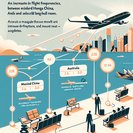
Airport Authority Hong Kong (AAHK) reported that Hong Kong International Airport (HKIA) handled 5.37 million passengers in October 2025, an 18% rise on the same month last year. Flight movements grew 9.1% to 34,465, and—crucially for global mobility—transfer and transit volumes surged 50.2% to 1.5 million, underscoring the hub’s accelerating return as a regional connector.
The sharp rebound follows completion of the HK$141 billion Three-Runway System, which formally entered service in July. With three parallel runways now operating, HKIA’s declared capacity has increased from 68 to 102 aircraft movements per hour. That uplift is already translating into more seat inventory: Cathay Pacific plans to restore 100% of pre-COVID capacity by March 2026, while foreign carriers such as United Airlines and British Airways have each added a daily frequency.
![Passenger Numbers at Hong Kong International Airport Jump 18% in October; Transfer Traffic Up 50%]()
Cargo volumes also posted a modest 2.9% gain to 455,000 tonnes, helped by growing e-commerce flows between the Pearl River Delta and North America. For relocation planners, the improved belly-cargo capacity means faster delivery of household goods and critical spare parts for project work across the Greater Bay Area.
AAHK’s operational turnaround is earning international recognition. On the same day the traffic data were released, aviation consultancy CAPA named HKIA “Asia Large Airport of the Year 2025”, citing the successful runway expansion, advanced biometric boarding trials and the airport’s carbon-neutral roadmap.
Practical implications for companies: expect shorter slot-constrained wait times when arranging group moves, better connectivity for multi-stop itineraries (for example, Sydney–Hong Kong–Delhi on a single ticket) and more competitive freight rates. Mobility teams should nonetheless monitor potential bottlenecks at security as the new passenger-security charge rises to HK$65 from 1 January 2026.
The sharp rebound follows completion of the HK$141 billion Three-Runway System, which formally entered service in July. With three parallel runways now operating, HKIA’s declared capacity has increased from 68 to 102 aircraft movements per hour. That uplift is already translating into more seat inventory: Cathay Pacific plans to restore 100% of pre-COVID capacity by March 2026, while foreign carriers such as United Airlines and British Airways have each added a daily frequency.

Cargo volumes also posted a modest 2.9% gain to 455,000 tonnes, helped by growing e-commerce flows between the Pearl River Delta and North America. For relocation planners, the improved belly-cargo capacity means faster delivery of household goods and critical spare parts for project work across the Greater Bay Area.
AAHK’s operational turnaround is earning international recognition. On the same day the traffic data were released, aviation consultancy CAPA named HKIA “Asia Large Airport of the Year 2025”, citing the successful runway expansion, advanced biometric boarding trials and the airport’s carbon-neutral roadmap.
Practical implications for companies: expect shorter slot-constrained wait times when arranging group moves, better connectivity for multi-stop itineraries (for example, Sydney–Hong Kong–Delhi on a single ticket) and more competitive freight rates. Mobility teams should nonetheless monitor potential bottlenecks at security as the new passenger-security charge rises to HK$65 from 1 January 2026.









